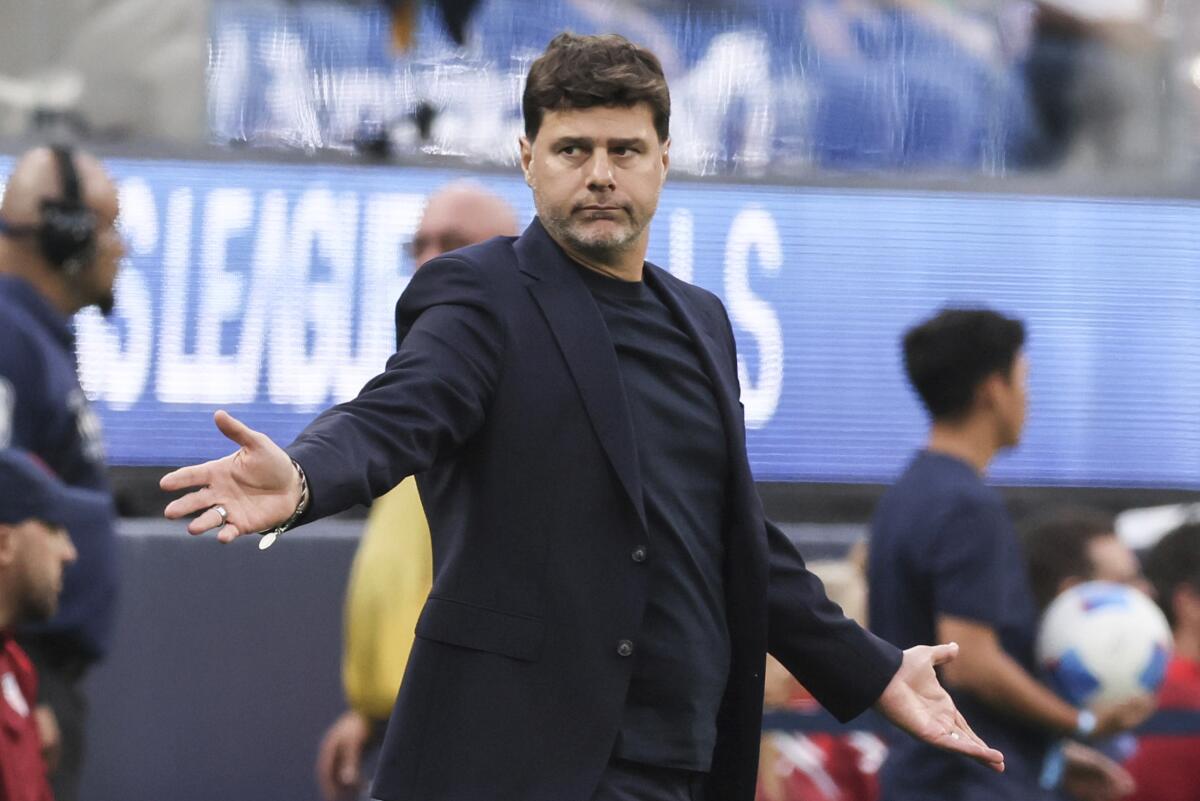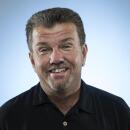Mauricio Pochettino is running out of time to revive U.S. before World Cup

- Share via
Mauricio Pochettino isn’t lacking confidence. But he is lacking results, and perhaps a dose of reality.
Speaking to journalists in London this month, the new national team coach said the U.S. “can be No. 1 in the world” in the next five to 10 years.
“For sure,” he emphasized.
For the time being, however, Pochettino’s team is no better than Panama — and Panama is ranked 36th in the world, which is a long way from No. 1.
In his most important test since taking the job last fall, Pochettino was unable to solve a bunkered-in Panamanian defense Thursday, falling 1-0 in the semifinals of the CONCACAF Nations League before a sparse crowd at SoFi Stadium. In the second semifinal, Mexico beat Canada 2-0 before a much fuller house on two goals from Raúl Jiménez.
President Trump’s economic and immigration policies, coupled with comments he has made about Canada and Mexico, has injected politics into the CONCACAF Nations League finals.
Mexico will face Panama in Sunday’s final while the U.S. will play Canada in the third-place game.
Failing to reach the final of a tournament the U.S. has won three times may not mean it’s time for Pochettino to push the panic button. But with his team scheduled to return to SoFi in less than 15 months for its World Cup opener, it may be time for the coach to at least find out where the panic button is, because if the U.S. continues to play without passion, purpose and a plan, it won’t win next year either.
“We need to find a way to compete better. And that’s it,” Pochettino said. “We are USA, but you cannot win with your shirt. You need to come here and be better and suffer and win the duels and work hard. If not, it’s not going to be enough.
“At the international level it’s not going to be enough.”
It wasn’t. But Pochettino’s team wasn’t just lacking goals. It lacked creativity, imagination, cohesion, fight and desire. And that’s just the short list.
“No excuses,” the coach said repeatedly. “They were hungry. That was the difference.”

The U.S. dominated in every statistical category, controlling the ball for more than an hour of the 90 minutes, taking four times as many shots, completing twice as many passes and taking three times as many corners.
But Panama had the only goal, from Cecilio Waterman four minutes into stoppage time. It was Panama’s only shot on target.
“The numbers never explain the game,” Pochettino said. “We had the possession, but we did not use it in a way that was aggressive.”
“I am very, very disappointed because the way that we approached the game and started the game wasn’t the right way,” he added. “We played too slow. We didn’t show aggression with the ball.”
Pochettino has until Sunday’s third-place game to come up with a response. And while the U.S. players weren’t always on the same page on the field Thursday, they were all reading from the same script afterward.
“We have to stay positive and keep moving forward as a team,” forward Christian Pulisic said. “It’s time to learn a bit, to get better.”
“We’re still going to stick to the principles and try to apply the things that we’ve been working on in a game,” goalkeeper Matt Turner agreed. “You can go one of two ways from a result like this. You either come back on Sunday, put together a good result, and you have a good feeling going into the summer. Or you can implode. But I don’t foresee that.”

In the second game, Jiménez gave Mexico a lead in the opening minute, scoring off a scramble at the top of the box, then doubled the margin on a gorgeous free kick from about 30 yards in the 75th minute. The brace gave the oft-injured Jiménez seven goals in his last six games with Mexico.
Thursday’s doubleheader was as much a test for the temporary grass carpet laid over SoFi’s synthetic Matrix Turf field as it was for the four teams. FIFA requires World Cup games to be played on natural surfaces, and eight of the 16 stadiums that will be used in next year’s tournament have artificial fields. Those venues will have to install grass for the World Cup.
SoFi’s 70x110-meter field, grown at a sod farm in Washington, was laid down in strips this month and was used for the first time Thursday. The ersatz surface will remain in place for Sunday’s games as well as for a women’s friendly between the U.S. and Brazil next month.
Otto Benedict, the stadium’s senior vice-president for facility and campus operations and the person overseeing the project in conjunction with FIFA, will study the field’s performance to ensure the surface will be able to hold up under the strain of eight World Cup games in 28 days.
Christian Pulisic, Weston McKennie and Tyler Adams will be part of the U.S. roster for the CONCACAF Nations League final four at SoFi Stadium.
“We are taking readings almost every single hour, if not more than that. We have systems in here that are looking at the ambient temperatures, the ambient moisture,” Benedict said of the multimillion-dollar process.
“It’s a learning opportunity.”
The same could be said for the U.S. under Pochettino, a team the coach had said could be among the best in the world inside a decade. But given Thursday’s performance, it’s also one that could be facing an early World Cup exit when it returns to SoFi for two of its three group-play games next year.
“We’re still building our identity,” Pulisic said.
Time, however, is running out.










